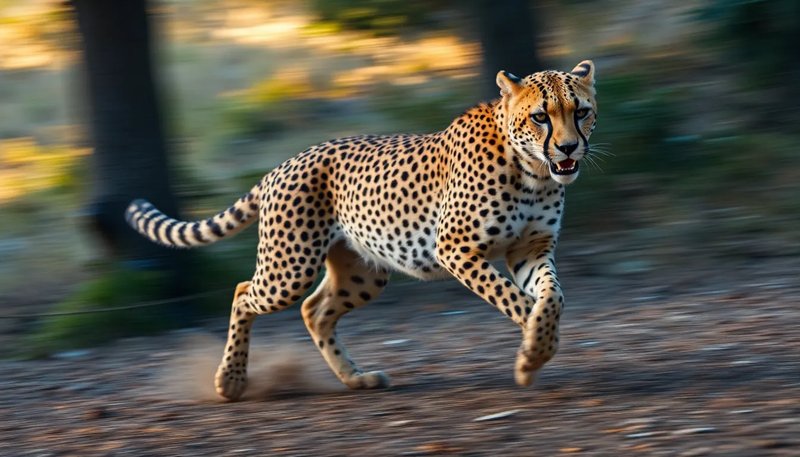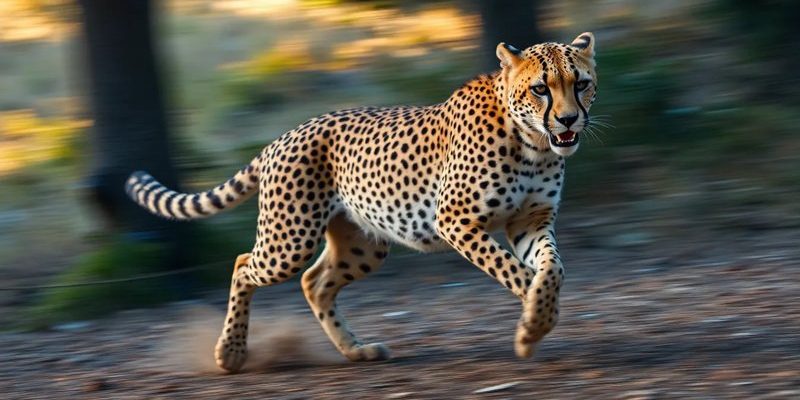
Understanding cheetahs can be as thrilling as watching them chase down prey. They’re not just speed demons; they have complex behaviors and ecological roles that shape their world. So, why is it that so many myths persist? Let’s dive into the most common misconceptions that might surprise you!
Myth 1: Cheetahs Are Just Fast Cats
You might think that being fast is the only noteworthy thing about cheetahs, but let me explain why that’s a limited view. Sure, cheetahs can reach speeds of up to 60 to 70 miles per hour, making them the fastest land animals. However, speed isn’t their only trait. These cats have unique physical adaptations that help them hunt. For example, their large nasal passages allow for quick oxygen intake during high-speed chases.
But speed comes with a cost. Cheetahs can only maintain such bursts of speed for about 20 to 30 seconds before overheating. After a chase, they need to rest and catch their breath. The next time you see a cheetah in a documentary, remember that it’s not just a speedster; it’s an athlete with an intricate balance of strengths and weaknesses.
Myth 2: Cheetahs Can’t Climb Trees
You might be surprised to learn that cheetahs *can* climb trees, even though they’re often seen on the ground. Many people assume they stick to open areas because of their streamlined build and speed. In reality, young cheetahs and mothers with cubs sometimes seek refuge in trees to avoid predators like lions or hyenas.
Cheetahs have sharp, retractable claws that help them grip branches. Plus, their lightweight frame makes climbing less challenging. This behavior not only provides safety but also gives them a better vantage point to spot prey. So, while they might not be as adept at climbing as leopards, they definitely have some skills in the tree-climbing department!
Myth 3: Cheetahs Are the Same as Leopards
Here’s the thing: while cheetahs and leopards share similar habitats and often get confused for one another, they are distinctly different species. Cheetahs have a unique body structure that makes them built for speed, while leopards are muscular and strong, perfect for climbing and hunting in trees.
Cheetahs have a slender frame with long legs and a small head, whereas leopards are stockier with a broader head. You might notice their spots too—cheetahs have solid black spots, while leopards have rosettes. The differences don’t end there. Cheetahs rely on their speed to catch prey, while leopards prefer ambush tactics, using their strength and stealth. Understanding these differences is key to appreciating what makes each species special.
Myth 4: Cheetah Cubs Are Born With Their Spots
When you hear about cheetah cubs, you might imagine tiny versions of their swift adult counterparts, but there’s a twist. Cheetah cubs are actually born with a thick, grayish fur known as “natal fur” that gives them a fluffy appearance and helps them camouflage within their environment. The iconic black spots start to develop as they grow older, usually around a couple of months.
This unique fur serves a purpose. In the wild, young cubs are vulnerable to predators, and their natal fur helps to blend them in with grasses and bushes, keeping them safe. As they mature, their spots develop, providing them with the distinctive look that we often associate with cheetahs. It’s nature’s way of ensuring their survival!
Myth 5: Cheetahs Are Poor Hunters
You might be wondering how cheetahs manage to stay alive if they’re often viewed as unsuccessful hunters. It’s true that they face challenges, but they’re far from poor at hunting. Cheetahs have an exceptional strategy for capturing prey that involves careful planning and teamwork, especially when they’re part of a coalition of male cheetahs.
When hunting solo, a cheetah will stalk its target, using its speed to sprint within a close range before making a dash. However, their success rate is about 50%, which is respectable compared to other big cats like lions. Plus, their unique adaptations, such as acute eyesight and a flexible spine, help them make sharp turns at high speeds, increasing their chances of success. Far from being ineffective, cheetahs have mastered a hunting style that works for them!
Myth 6: Cheetahs Are Not Endangered
Another misconception is that cheetahs are thriving in the wild. Unfortunately, that’s not the case. Cheetah populations have dwindled significantly over the past century due to habitat loss, climate change, and human-animal conflict. They are classified as vulnerable by the International Union for Conservation of Nature (IUCN).
Conservation efforts are crucial to ensure these remarkable animals don’t vanish. Organizations worldwide work to protect their habitats and educate communities about coexisting with wildlife. By understanding their plight, we can all play a role in preserving the future of cheetahs. Supporting wildlife conservation initiatives can make a big difference!
Myth 7: Cheetahs Always Hunt Alone
Although you often see individual cheetahs on nature documentaries, they’re not loners by nature. Cheetahs have social structures that sometimes involve living in groups, particularly among males. These male coalitions typically consist of brothers who stick together to defend their territory and increase hunting success.
On the flip side, female cheetahs often hunt alone and raise their cubs without male assistance. However, their social dynamics can be complex. Understanding these relationships is essential for fully grasping how cheetahs thrive in the wild. It’s a reminder that they are not just solitary figures but part of a broader social fabric!
There you have it, a closer look at some common myths and misconceptions about the cheetah. These animals, with their blend of speed, beauty, and social structures, are much more complex than we typically give them credit for. By debunking these myths, we can appreciate what makes cheetahs truly unique and understand the challenges they face in the wild.
So next time you think of cheetahs, remember there’s a rich world of facts waiting to be explored. Whether it’s their hunting strategies or social structures, these incredible animals deserve our attention and protection. Let’s keep learning and supporting efforts to preserve the amazing wildlife around us!

